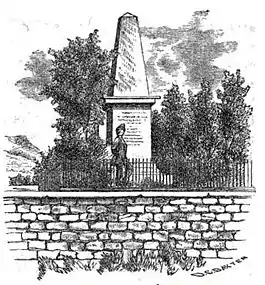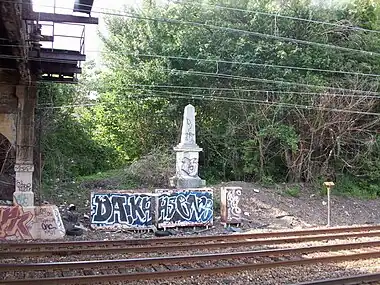Newkirk Viaduct Monument
The Newkirk Viaduct Monument (also, Newkirk Monument) is a 15-foot (4.6 m) white marble obelisk in the West Philadelphia neighborhood of Philadelphia, Pennsylvania. Installed in 1839, it is inscribed with the names of 51 railroad builders and executives, among other information.
 2018 photo | |
| 39.9400°N 75.2063°W | |
| Location | West Philadelphia |
|---|---|
| Designer | Thomas Ustick Walter |
| Type | obelisk |
| Material | white marble |
| Width | 5 feet (1.5 m) |
| Height | 14 feet (4.3 m) |
| Completion date | 1839 |
| Dedicated to | Matthew Newkirk |
| Moved from original location sometime after 1927. Moved to current location in 2016.[2] | |
Designed by Thomas Ustick Walter, a future Architect of the Capitol, the monument was erected by the Philadelphia, Wilmington and Baltimore Railroad to mark its completion of a bridge across the Schuylkill River and the first railroad line south from Philadelphia. The monument, which originally sat about 700 feet (210 m) from the riverbank, was moved sometime after 1927 about 600 feet (180 m) further inland, where it sat for decades by the main line that became Amtrak's Northeast Corridor. In 2016, it was moved to its present location, about 100 feet (30 m) from the river's edge at the north end of the Bartram's Mile section of the Schuylkill River Trail.
History
The monument commemorates the 1838 completion of the Newkirk Viaduct, also called the Gray's Ferry Bridge, over the Schuylkill River. The bridge completed the first direct rail line between Philadelphia and Baltimore, Maryland — tracks that closely paralleled the King's Highway, the main land route to the southern states.
On August 14, 1838, the PW&B board of directors decided to name the bridge after company president Matthew Newkirk (1794–1868), a Philadelphia business and civic leader, and to commission a monument at its west end. (Earlier in the year, the company gave Newkirk a silver plate worth $1,000 ($27,481 today[3]) to reward him for arranging the merger of four railroads that together built the Philadelphia-Baltimore line.)[4]
Designed by Thomas Ustick Walter,[5] who would go on to design the dome of the U.S. Capitol, the white marble monument consists of seven pieces of carved stone held together simply by weight and friction — not reinforced, for example, with metal pins. The uppermost piece, a 7-foot (2.1 m) obelisk, weighs about 6,000 pounds (2,700 kg), while the 5-foot (1.5 m) base and other pieces weigh a rough total of 12,000 pounds (5,400 kg).[2] The obelisk and base are inscribed with the names of 51 men,[6] including senior officials of the four railroads and various employees who helped build the bridge and rail line.[7][8]
The monument was installed along the western approach to the bridge and surrounded by a low iron fence.[7] An 1895 account describes its location as "on a high bank in the angle formed by the junction of the Philadelphia, Wilmington and Baltimore Railroad and the Chester Branch of the Philadelphia and Reading Railway just below the western end of the Gray's Ferry Bridge."[9] It sat about 700 feet (210 m) from the Schuylkill River, at 39.93975 north latitude, 75.20830 west longitude.[10]
In 1872, the PW&B built a new mainline west of the Viaduct. It leased its old line to the Philadelphia and Reading Railway, which built a small railyard, surrounding the monument.
After a half-century, the monument had fallen into obscurity, except perhaps to vandals. "Surrounding the structure is an iron fence to protect it from vandalism, but it has, nevertheless, been a frequent target for irresponsible hoodlums," the Philadelphia Inquirer wrote in 1896.[11] In 1900, the Philadelphia Record wrote of the monument: "On account of its inaccessibility and the dense foliage, it is scarcely ever seen."[12]
Ca. 1930 move
By January 1926, the Pennsylvania Railroad was making plans to move the monument "because of the additional yard facilities which are required at that point. The understanding is that it will be placed on the present site of the Gray's Ferry Station. The engineering department of the Pennsylvania Railroad has the matter in charge."[13]
A May 1927 aerial photo shows it still in its original location.[14] But presently, it was moved to the site of the now-demolished station, along the 1872 mainline, just northeast of the 49th Street Bridge, at 39.939492 north latitude, 75.210633 west longitude.[10][15] It seems to have been moved by September 1930, when a reader asked the Inquirer about "a monument beside the Pennsylvania Railroad near the first overhead crossing which is located about Forty-Eighth or Fiftieth Street".[16] (In 1939, a retired Pennsylvania Railroad employee—perhaps having forgotten the actual year of the move—told the Delaware County Daily Times that the monument had been moved in late 1917 to make way for the "Hog Island Railroad"—formally, the 60th Street Branch of the Pennsylvania Railroad—and that three of Newkirk's daughters had been asked their permission for the move.[17])
For the next eight decades, the monument sat all but abandoned, in disrepair, and nearly forgotten, though it was visible to passengers traveling Amtrak's Northeast Corridor or SEPTA Regional Rail trains on the Airport Line and the Wilmington/Newark Line.[8]
2016 move
In 2013, interest in the Newkirk Monument was rekindled by a pair of articles written by Bradley Peniston for Hidden City Philadelphia, a local organization about the built environment. The articles explored the monument's significance and suggested it be moved to a more visible site. Over the next few years, the idea was embraced and brought to fruition by a host of public and private entities, including Amtrak, Philadelphia Parks & Recreation, Schuylkill River Development Corporation, landscape architects Andropogon Associates, planners PennPraxis, conservators Materials Conservation, and movers with the George Young Company. On November 17–18, 2016, the monument was moved to a new concrete pad along the under-construction "Bartram's Mile" section of the Schuylkill River Trail.[2]
 1856 Drawing
1856 Drawing In 2009
In 2009 Monument as seen from tracks in 2009
Monument as seen from tracks in 2009
Inscription
As transcribed by Wilson, the four sides of the monument and its base are inscribed as follows:[9]
Eastern face |
Western face |
Northern face |
Southern face |
| Obelisk | |||
|---|---|---|---|
PHILADELPHIA WILMINGTON AND BALTIMORE RAILROAD COMPANY
President Vice President Directors Secretary, ALLAN THOMSON. AUBRY H. SMITH,[21] Ass't. |
BALTIMORE AND PORT DEPOSIT RAILROAD COMPANY President Directors Secretary and Treasurer, Engineer, Assistant Engineer, |
DELAWARE AND MARYLAND RAILROAD COMPANY. President, Directors: Engineer, Assistant Engineer, |
WILMINGTON AND SUSQUEHANNA RAILROAD COMPANY. President, Directors Secretary, Treasurer, Engineer, Assistant Engineer, |
| Base | |||
THE PHILADELPHIA WILMINGTON AND BALTIMORE RAILROAD COMPANY Formed A.D. 1838 by the
Union |
Railroad Contractors: Superintendents: |
NEWKIRK VIADUCT Samuel H. Kneass, Engineer. |
NEWKIRK VIADUCT Commenced July 4, 1837. |
Wilson's transcription contains several errors; for example, it misspells the last names of Henry Hazlehurst, Edward Tatnall, and Charles and Alexander Provest.
References
- Maule, Bradley (December 6, 2016). "A Moving Monument". Hidden City Daily. Philadelphia: Hidden City Philadelphia.
- 1634–1699: McCusker, J. J. (1997). How Much Is That in Real Money? A Historical Price Index for Use as a Deflator of Money Values in the Economy of the United States: Addenda et Corrigenda (PDF). American Antiquarian Society. 1700–1799: McCusker, J. J. (1992). How Much Is That in Real Money? A Historical Price Index for Use as a Deflator of Money Values in the Economy of the United States (PDF). American Antiquarian Society. 1800–present: Federal Reserve Bank of Minneapolis. "Consumer Price Index (estimate) 1800–". Retrieved May 28, 2023.
- "1838 (June 2004 Edition)" (PDF). PRR CHRONOLOGY. The Pennsylvania Railroad Technical & Historical Society. June 2004. p. 2. Retrieved 23 July 2013.
- Newkirk Viaduct data from the Philadelphia Architects and Buildings (PAB) project of the Athenaeum of Philadelphia
- Peniston, Bradley (July 9, 2014). "The Monument Men". Hidden City Daily. Retrieved January 26, 2018.
- Dare, Charles P. (1856). Philadelphia, Wilmington and Baltimore railroad guide: containing a description of the scenery, rivers, towns, villages, and objects of interest along the line of road; including historical sketches, legends. Vol. 1. Fitzgibbon & Van Ness. p. 115.
- Baer, Christopher (2002-05-08). "Do You Wanna Know More?". Philadelphia Weekly. Archived from the original on 2012-02-22. Retrieved 2009-06-06.
- Wilson, William Bender (1895). History of the Pennsylvania Railroad Company with Plan of Organization, Portraits of Officials and Biographical Sketches. Vol. 1. Philadelphia: Henry T. Coates & Company. pp. 296–299. Retrieved November 25, 2012.
- "Where Did the Newkirk Monument Originally Stand?". Friends of the Newkirk Monument. 2015-09-04. Archived from the original on February 9, 2019. Retrieved 2018-01-26.
- "Forgotten Monuments of this City". Philadelphia Inquirer. 23 February 1896. p. 25. Retrieved 28 March 2022.
- "City's Fine New Bridge". Philadelphia. Philadelphia Record. August 12, 1900. p. 15. Retrieved September 25, 2013.
- "23 Jan 1926, Page 6 - The News Journal at Newspapers.com". Newspapers.com. Retrieved 2022-04-30.
- "Van Sciver Schuylkill Plant". Hagley Digital Archives. 1927-07-05. Retrieved 2020-09-09.
- "BridgeReports.com | 49TH STREET over AMTRAK(NY-WASH BRANCH), Philadelphia County, Pennsylvania". bridgereports.com. Retrieved 2022-04-30.
- "Penna Railroad Monument". The Philadelphia Inquirer. 1930-09-17. p. 12. Retrieved 2022-04-30.
- "Newkirk Shaft at Grays Ferry / Delaware County Daily Times". Newspapers.com. 10 Apr 1939. p. 8. Retrieved 2020-09-09.
- The spelling of the last name seems to be in error; it should be "Connell". Minor, D. K.; Schaeffer, George C., eds. (January 21, 1837). "Wilmington and Susquehanna Railroad Company". New York. American Railroad Journal and Advocate for Internal Improvements. p. 34. Retrieved 18 August 2013.
- "Jr John McKim b. 28 Mar 1766 Baltimore, Independent Cities, Maryland, USA d. 16 Jan 1842: JHBL Genealogy". latrobefamily.com.
- Misspelled; it is spelled "Aubrey". Annual Report of the Philadelphia, Wilmington and Baltimore Rail Road, 1838–40. Philadelphia: Philadelphia, Wilmington and Baltimore Rail Road Company. 1838–40.
- Cohen briefly served as B&PD president in 1838 after Brantz died. On Feb. 20, after the railroad mergers, he became PW&B vice president. "1838 (June 2004 Edition)" (PDF). PRR CHRONOLOGY. The Pennsylvania Railroad Technical & Historical Society. June 2004. p. 2. Retrieved 23 July 2013.
- The last name is misspelled. It is "Hazlehurst". JHBL Family Genealogy
- [sic] His last name was spelled "Tatnall"."Records of Vice President Henry Tatnall, 1897-1940 (bulk 1909-1940)". Hagley Museum and Library - Manuscripts and Archives Department. Worldcat. Retrieved October 1, 2013.
- Appointed Superintendent of Transportation for the Baltimore and Port Deposite on Jan. 26, 1837."1837 (June 2004 Edition)" (PDF). PRR CHRONOLOGY. The Pennsylvania Railroad Technical & Historical Society. June 2004. Retrieved 21 March 2014.
- Son of superintendent Charles Lombaert. Later the assistant to Pennsylvania Railroad chief engineer Herman Haupt and ultimately a vice president of the PRR.
External links
- "Newkirk Monument," Schuylkill Banks Development Corporation, May 5, 2017.
- Photos of the 2016 move, via Flickr.
- Kelly, Sara (2002-05-01). "I Wanna Know". Philadelphia Weekly. Retrieved 2009-06-06.
- Maule, Bradley (March 13, 2013). "Wrong Side Of The Tracks: Newkirk Viaduct Monument In Photos". Hidden City Philadelphia. Retrieved March 15, 2013.
- Peniston, Bradley (August 26, 2015). Video: "Where Did the Newkirk Monument Originally Stand?"
- Spivak, Joel. "Newkirk Viaduct Monument". Society for Industrial Archaeology Car Barn Tours. phillytrolley.org. Retrieved 2009-06-06.